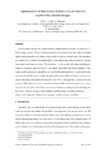Optimisation of Thin-Walled Hybrid Vertical Struts for Crashworthy Aircraft Designs

Use this link to cite
http://hdl.handle.net/2183/24912Collections
- Investigación (ETSECCP) [826]
Metadata
Show full item recordTitle
Optimisation of Thin-Walled Hybrid Vertical Struts for Crashworthy Aircraft DesignsDate
2020Citation
Paz, J., Díaz, J., Romera, L. et al. Struct Multidisc Optim (2020) 61: 141. https://doi.org/10.1007/s00158-019-02350-3
Abstract
[Abstract] This research concerns the crashworthiness enhancement of a model of a Boeing 737-200 fuselage section. Using a validated numerical specimen, four thin-walled crushable hybrid energy absorbers are added to the aircraft to work as vertical struts. The absorbers are composed of a hollow aluminium tube, a star-shaped glass fibre–reinforced polymer inner matrix and foam extrusions. The absorbers—with variable tube edge and thickness, composite thickness and core height—are single- and multi-objectively optimised. Surrogate models and genetic algorithms are used for the minimisation of acceleration loads, injury levels and the strut’s weight. Results yield a more efficient frames’ collapse evolution with plastic dissipation increased by over 50%. Consequently, acceleration peaks are up to 50% lower at the two measured locations while maintaining low mass values. Injury levels were also reduced from severe to moderate according to an Eiband diagram.
Keywords
Aircraft design
Crashworthiness
Hybrid energy absorbers
Biometric criteria
Multi-objective optimization
Surrogate models
Genetic algorithms
Crashworthiness
Hybrid energy absorbers
Biometric criteria
Multi-objective optimization
Surrogate models
Genetic algorithms





